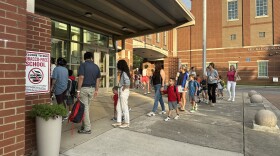If you want to get a better sense of how police operate in schools in North Carolina, you’re going to have a hard time getting that information. Schools are supposed to track the number of students they refer to police. But many districts aren’t doing that.
Search Number Of Referrals At Area Schools
Related Stories
More In Education
-
It’s been 50 years since the Individuals with Disabilities Education Act (IDEA) was signed into law, and the milestone comes at a time when parents and activists are concerned about funding cuts.
-
South Piedmont Community College is the latest community college to formalize its participation in Wolfpack Connect, a new program that offers guaranteed admissions to NC State University for community college students.
-
Charlotte-Mecklenburg Schools’ enrollment has fallen to its lowest point in more than a decade, according to new state data — and the trend mirrors declines across North Carolina’s traditional public schools.
-
The Charlotte-Mecklenburg Schools Board of Education extended Superintendent Crystal Hill’s contract and approved a raise Tuesday night. The raise is contingent on the General Assembly approving pay raises for teachers.
-
The Charlotte-Mecklenburg Schools Board of Education officially welcomed four new members at its meeting Tuesday night.
-
A student at Ardrey Kell High School is suing the Charlotte-Mecklenburg Board of Education after the district initially claimed her painting of the school’s spirit rock amounted to vandalism.
-
The move comes two months after trustees voted to keep a picture book, "Call Me Max," about a transgender boy in the children’s section.
-
The Union County chapter of the NAACP says Union County Public Schools has failed to make good on an agreement to partner on several education initiatives. The school district denies this.
-
Across the U.S., nearly 230,000 students were referred to law enforcement during the 2017-18 school year. Black students and students with mental and physical disabilities were referred at nearly twice their share of the overall student population. That’s what a Center for Public Integrity analysis of U.S. Department of Education data found. In North Carolina and South Carolina, law enforcement was also brought in at higher rates when it came to Black and disabled students.





















